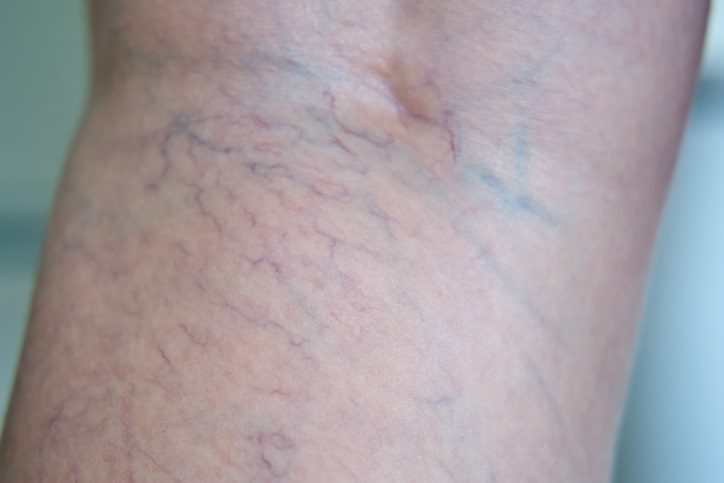Your body consists of a network of interconnecting vessels that transport blood to and from the heart. You can sometimes see your veins as light blue or green lines against the thinner parts of your skin, like the wrist. But usually, they are not very noticeable compared to the rest of your skin.
If you see your veins begin to protrude and bulge from the skin and look harsher in color, this can point to a temporary concern that may go away on its own. Or it may point to damage within the veins, especially if the symptom persists on a chronic basis.
You will need to meet with a vein specialist to determine the underlying cause of these vascular changes. Then they can provide treatment if needed. The doctor can return your veins to a more aesthetically appealing appearance. Read on to learn about three reasons why you might see bulging or discolored veins appear more highly visible against your skin than usual.

Thinning Skin
As mentioned, veins already naturally appear more visible where the skin is thin. If you lose weight, then your skin might also become thinner, making your veins more prominent, especially in your hands.
But your skin can change along with the rest of your body when you grow older. The skin will lose its elasticity, making it thinner. As a result, your veins can appear more starkly against the skin than they once did. You cannot always stop the effects of aging. But you can learn more about their impact on your vein health when you consult with a vascular doctor.
Acute Venous Reaction
Sometimes, you may experience a temporary effect of bulging veins in your legs, hands, or feet. Your veins might respond to external temperatures, for instance.
Warm weather may make your body send extra blood toward the skin in an effort to cool down. This excess blood may result in a change in the veins’ appearance. In colder conditions, the veins might constrict. Then you might see an increase in blood pressure as blood tries to move in the narrower vessels, which can give you bulging veins.
Exercise, such as weightlifting or cardio, will also increase blood flow, which might make the veins more noticeable for a period of time. This reaction is normal. If the veins seem uncomfortable and visible on a chronic basis, you might want to talk to a doctor.
Vein Diseases
Chronic bulging or discoloration in the veins might also point to a vein disease like varicose veins. This disorder happens when there is a malfunction in the valve of a blood vessel that allows blood to pool within a vein. It will then appear more vividly against the skin.
Frequently Asked Questions
Why do veins look more pronounced when I lose weight?
Losing weight can reduce the layer of fat beneath the skin, making veins stand out more clearly. Thinner skin offers less coverage, so naturally, veins become more visible. This effect is usually harmless and does not always signal a medical issue. If the veins appear severely bulging or painful, though, it may be time to consult a doctor.
Do veins that pop out after a workout mean something is wrong?
Usually, no. Exercise boosts blood circulation and can cause veins to expand so that extra blood can move through. This may create a temporary bulge, especially if lifting weights or doing vigorous activity. Once the body recovers and settles, the veins become less visible again. If bulging persists or causes discomfort, talk to a vein specialist.
Can spider veins be just as concerning as varicose veins?
Spider veins can also signal vascular stress, although they’re usually smaller and appear like thin red or purple lines. They form when pressure on the vessels or vein walls weakens. While often more of a cosmetic issue than varicose veins, spider veins can still point to underlying circulation problems. If new or extensive networks of spider veins appear, seeking medical input is wise.
Can I treat thinning skin to hide my veins?
Some skincare routines or cosmetic procedures may slightly thicken or enhance skin quality, making veins less obvious. However, thinning skin from aging is natural and not entirely reversible. If a vein-related issue underlies the problem, addressing that root cause is more helpful than trying to mask it. Consulting a doctor can clarify whether skin or vein treatments are the best option.
When do I need to seek treatment for visible veins?
If the veins cause pain or discomfort or seem to worsen over time, it’s time to see a doctor. Symptoms like persistent swelling, rashes, or sores on the skin indicate a more serious issue. Even without discomfort, a sudden appearance of multiple visible veins can warrant a doctor’s attention. They can diagnose any potential vein disease and suggest the right approach to manage it.
Are there preventative measures to keep veins from protruding?
Maintaining a healthy lifestyle, consistent exercise, and a balanced diet can support good circulation. Staying hydrated also helps, as does avoiding long periods of standing or sitting. Compression stockings can give extra support to your legs. While these steps may not prevent every visible vein, they can reduce the strain on blood vessels and lower the risk of varicose veins.
If the veins weaken or sustain other types of damage, you might see skinnier, discolored lines on the skin, known as spider veins. Both varicose veins and spider veins will need treatment from a vein doctor to get rid of, though they are rarely life-threatening.
